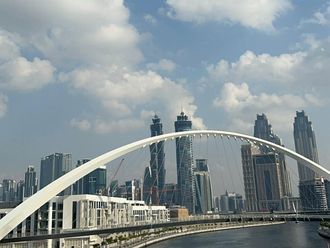16:03 Gulf News: There is no such thing as a peaceful protest.
16:07 Aisha Naseem: Peaceful protests don’t work on their own. ‘Peaceful protest’ is an oxymoron. Throughout history, we have seen there is always a violent shock, which gives the movement the push and the acceleration.
16:07 Govind Mohandas: I disagree. Peaceful protests are part of nonviolent resistance, which has existed for ages. A great example is the Salt March led by Mahatma Gandhi which was a part of the famous Civil Disobedience Movement during the British rule in India. Another special mention would be the Woman Suffrage Parade in the US in 1913. Could anything be more peaceful than just walking?
16:07 Sruthi Shiva: Independence and rights have been won in many cases by peaceful methods. It is one of the most effective ways as violence leads to more violence. If protesters turn violent, a government can more legitimately crack down on them. The problem with violence is that only a smaller part of society will join in. Most people can join peaceful protests, boycott products and do sit-ins.
16:08 Madhu Madan: Peaceful protests are prevalent and I fully support them. I believe that peaceful protests are the best means to bring any social change. They have in the past. Mohandas Gandhi and Nelson Mandela proved that nonviolent protests do work in the long run.
16:08 Samina Kausar: Of course it is effective, because having your opinion is good but expressing your point of view to someone in a violent way is not sensible. If you have a conflicting opinion, deliver your message peacefully rather than having a fight or quarrel. Each life is important.
16:12 Afifah Luqman: I think peaceful protests work. The point of a protest is to have your opinion registered and to put pressure on the relevant government for rights. We live in an age where even online protests would work, if there are enough people concerned.
16:13 Raunak Kapur: It depends on the citizens. If the citizens are well-educated about the fact that violence won’t lead the nation anywhere, then people make sure that without raising their voice they can express their opinion.
16:18 Gulf News: Force is necessary, if you want people to listen.
16:20 Govind Mohandas: This is very similar to when someone is ignoring you — you talk and they don’t listen. However, if you hit them, they will respond. They might respond negatively but at least they are responding. Violent protests lead to a lot of deaths and damage of property but certainly have higher success rates. How often do you see peaceful protests work? As often as you see Halley’s Comet. Last week, a retired school teacher in Detroit, US, was tasered for peacefully protesting. If the police are going to act the same to both these forms of protests, why not go for the violent ones?
16:21 Raunak Kapur: Force is not the only element that will make people listen. They are simply being forced to listen. Instead, without raising our voice, if we convey our opinion without using any element of force ... it is conveyed to the concerned authorities in a more efficient way.
16:22 Aisha Naseem: Then what was the need for an Arab Spring? Why aren’t people in Syria sitting down for a peaceful conversation? I’m not supporting bloodshed, but you need a big bang to get the other party to listen.
16:22 Afifah Luqman: Sit-ins and marches are powerful because they have a large number of people coming out on the streets for a cause. They may not necessarily bring change, but it makes the government aware that they have a very strong opposition ... more of a psychological victory.
16:23 Madhu Madan: A nonviolent protest is a moral protest because force or violence is not used. It is a very powerful tool because the authority is put on the spot and does not know how to respond without offending the general public. It does not create hatred, rather, public awareness of a serious problem that requires a solution.
16:23 Samina Kausar: By force, you can make people listen but not every time. Doing so in a peaceful manner can connect with their hearts and minds, while by using force you are just implementing your idea.
16:24 Sruthi Shiva: If we win a battle violently, the losing team after some time can return with more violence. So even after winning it will be a constant battle going on. But through peaceful methods and negotiations we can get what we want peacefully and without much damage to human life and property.
16:30 Shajitha Shifa: Yes, a peaceful protest is much powerful than violence. There is nothing to lose — it is just a talk between two conflicting parties to come to a conclusion, which is fair for both teams, which will maintain the country’s harmony.
16:31 Afifah Luqman: No, not if you are supporting a cause that is either popular or is right. A good cause doesn’t need force for people to support it.
16:32 Gulf News: True nonviolence is the only way to bring change, otherwise it is just a fight.
16:33 Govind Mohandas: The key word here is “only”. Keeping the previous statement in mind, I am against this statement. It is true that nonviolence is the best way to bring change but not the ‘only’ way.
16:35 Madhu Madan: I believe in nonviolence and agree that this is the only way to bring change, otherwise it is just a fight which can become deadly, taking many lives, taking a toll on property and nations’ economy. Violence leads to more violence.
16:35 Aisha Naseem: I agree with Govind. The operative word here being ‘only’. There are all kinds of ways to bring change or win a battle. Nonviolence is the one good way to sort out differences, at whatever level they maybe, but its definitely not the ‘only’ way.
16:37 Raunak Kapur: By using violence, no one suffers but the country and its citizens. National economy goes down, death toll increases, there is loss of property and valuables. But by nonviolence, no one suffers and their required work is done.
16:37 Afifah Luqman: I agree. Peaceful protests are about standing up for what you believe in and not about showing strength. At the end of the day, it is about the cause and the support it gets. However, change by force may also work, if people accept it. It all depends on what people want.
- Compiled by Huda Tabrez/Community Web Editor












